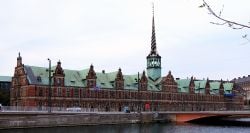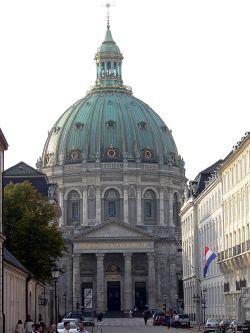Difference between revisions of "Copenhagen" - New World Encyclopedia
Mary Anglin (talk | contribs) |
Mary Anglin (talk | contribs) |
||
| Line 38: | Line 38: | ||
|55°43' N<br />12°34' E | |55°43' N<br />12°34' E | ||
|} | |} | ||
| − | + | [[Image:S13.gif|thumb|250px|Map of Copenhagen suburbs as part of The Finger Plan.]] | |
'''Copenhagen''', the capital and largest city of [[Denmark]], is located on the [[Zealand]] and [[Amager]] Islands, and is separated from [[Malmö]], [[Sweden]], by the strait of [[Øresund]]. | '''Copenhagen''', the capital and largest city of [[Denmark]], is located on the [[Zealand]] and [[Amager]] Islands, and is separated from [[Malmö]], [[Sweden]], by the strait of [[Øresund]]. | ||
| Line 46: | Line 46: | ||
==Geography== | ==Geography== | ||
| − | |||
| − | |||
| − | |||
| − | |||
The original name for the city, from which the contemporary Danish name is derived, was ''Køpmannæhafn'', meaning "merchants' harbor." The English name for the city is derived from its [[Low German]] name, ''Kopenhagen''. The city's [[Latin language|Latin]] name is ''Hafnia'', after which the element [[hafnium]] is named.<ref>[http://nobelprize.org/nobel_prizes/chemistry/laureates/1943/hevesy-bio.html Biography of George de Hevesy]</ref>. | The original name for the city, from which the contemporary Danish name is derived, was ''Køpmannæhafn'', meaning "merchants' harbor." The English name for the city is derived from its [[Low German]] name, ''Kopenhagen''. The city's [[Latin language|Latin]] name is ''Hafnia'', after which the element [[hafnium]] is named.<ref>[http://nobelprize.org/nobel_prizes/chemistry/laureates/1943/hevesy-bio.html Biography of George de Hevesy]</ref>. | ||
| Line 67: | Line 63: | ||
==History== | ==History== | ||
| − | |||
[[Image:Copenhagen 1895.jpg|thumb|right|250px|Copenhagen c. 1895.]] | [[Image:Copenhagen 1895.jpg|thumb|right|250px|Copenhagen c. 1895.]] | ||
| − | |||
[[Image:Rundetårn view 2.jpg|thumb|right|250px|View from [[Rundetårn]]]] | [[Image:Rundetårn view 2.jpg|thumb|right|250px|View from [[Rundetårn]]]] | ||
| Line 91: | Line 85: | ||
Since the summer 2000, the cities of Copenhagen and [[Malmö]] have been connected by a toll [[bridge]]/tunnel ([[Oresund Bridge|Øresund Bridge]]), which allows both rail and road passengers to cross. As a result, Copenhagen has become the centre of a larger metropolitan area which spans both nations. The bridge has changed public transport and has led to the extensive redevelopment of Amager, south of the main city. | Since the summer 2000, the cities of Copenhagen and [[Malmö]] have been connected by a toll [[bridge]]/tunnel ([[Oresund Bridge|Øresund Bridge]]), which allows both rail and road passengers to cross. As a result, Copenhagen has become the centre of a larger metropolitan area which spans both nations. The bridge has changed public transport and has led to the extensive redevelopment of Amager, south of the main city. | ||
| + | <center><gallery> | ||
| + | Image:Littlemermaid207.jpg|The Little Mermaid statue in Copenhagen harbor | ||
| + | Image:Copenhagen amalienborg seen from opera house.jpg|Amalienborg Palace, home of the [[Danish royal family]]. The domed Marble Church is at center | ||
| + | Image:Norrebro.jpg|[[Nørrebro]] seen from "Søerne" | ||
| + | Image:Copenhagen Kongens Nytorv.jpg|[[Kongens Nytorv]] | ||
| + | </gallery></center> | ||
==Government== | ==Government== | ||
Revision as of 07:42, 6 September 2008
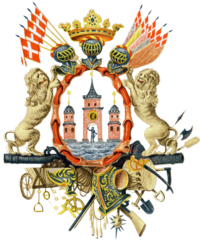
| |
| City coat of arms | |
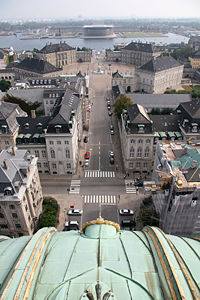
| |
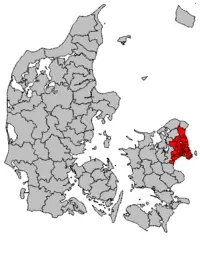
| |
| Area | |
|---|---|
| - Municipal | 88.25 km² |
| - Capital region | 2673 km² |
| Population (2008-01-01) | |
| - Municipal | 509,861 |
| - Urban area | 1,153,615 |
| - Metropolitan Area(Central Øresund Region) | 2,812,977 |
| - Density (city/met/region/region+) | 5777/1947/812/686/km² |
| Additional information | |
| Time zone | Central European: UTC+1 |
| Latitude Longitude |
55°43' N 12°34' E |
Copenhagen, the capital and largest city of Denmark, is located on the Zealand and Amager Islands, and is separated from Malmö, Sweden, by the strait of Øresund.
With the completion of the transnational Oresund Bridge in 2000, Copenhagen and Malmö are connected by a car/rail link and are in the process of integrating their labour markets, resulting in increasing numbers of commuters from both sides. These two cities together form the center of the Øresund Region, which is home to almost 3.7 million inhabitants.
In 2008, the magazine Monocle listed Copenhagen first in their Top 20 Most Livable Cities Chart[1], and gave the city the special award as "Best Designed City." In addition, it has also been classified as a GaWC Cultural World City, while it is third in Western Europe in terms of attracting regional headquarters and distribution centers, only surpassed by London and Paris.[2]
Geography
The original name for the city, from which the contemporary Danish name is derived, was Køpmannæhafn, meaning "merchants' harbor." The English name for the city is derived from its Low German name, Kopenhagen. The city's Latin name is Hafnia, after which the element hafnium is named.[3].
Copenhagen is located on the eastern shore of the island of Zealand (Sjælland) and partly on the island of Amager, and faces the Øresund, the strait of water that separates Denmark from Sweden, and that connects the North Sea with the Baltic Sea. On the Swedish side of the sound, directly across from Copenhagen, lie the towns of Malmö and Landskrona.
Copenhagen is also a part of the Øresund region, which consists of Zealand, Lolland-Falster and Bornholm in Denmark, and Scania in Sweden.
The weather in Copenhagen is mild through all four seasons. Summers bring temperatures averaging around 68°F (20°C), while in mid-winter temperatures hover just above or below zero. Rainfall is moderate and spread throughout the year, so showers are possible in any season. Mean annual precipitation is 23.1 inches (589mm). Grey skies are the norm rather than the exception in Copenhagen.
The Rådhuspladsen, or the “Town Hall Square,” is the old center of the city, from which an old shopping street leads northeast to Kongens Nytorv, or “King’s New Square,” which was laid out in the 17th century. Christiansborg Palace, which is built on the site of Bishop Absalon's old castle, is located on the island of Slotsholmen, or “Castle Islet.”
Suburban Copenhagen is planned according to "The Finger Plan," initiated in 1947, dividing the suburbs into five fingers. The S-train lines are built according to The Finger Plan, while green belts and highways are built in-between the fingers
The northern suburbs, forming the little finger of the plan, are the wealthiest, with mansions, larger houses, garden cities and mid-size houses. The north-northwestern suburbs form the ring finger, with detached middle-class dwellings. The northwestern suburbs form the middle finger, and consists of detached middle-class dwellings, widespread garden cities, large, low-rise public housing projects, and industrial areas.
The pointer finger suburbs are in the west, and have the lowest income per capita and the highest crime-rate. The southwest suburbs along the coast form the thumb, and include high-rise housing projects and low-income inhabitants. Amager island was later included in the city's suburban plan. Copenhagen covered 1032 square miles (2923 square kilometers) in 2008.
History
Signs of human activity dating back to about 4000 B.C.E. have been found around Copenhagen, but there are no signs of permanent settlements from that time.[4] Archaeological excavations indicate that the first town dates back to the 11th century and consisted of two settlements, one in the western part of the medieval city encircled by what is now the streets of Mikkel Bryggersgade, Vestergade, Gammeltorv/Nytorv and Løngangsstræde, which roughly corresponds to the coastline of the time,[5] and another smaller settlement at what is now Kongens Nytorv.[6][7] The surrounding area consisted of moist beach meadows and signs of cattle grazing have been found.[5] The city probably had a harbour located at present day Højbro Plads.[8]
From the Viking Age (c.700 to 1066) there was a fishing village by the name of "Havn" (harbour) at the site. In 1167, the year that marks the foundation of Copenhagen, Bishop Absalon of Roskilde, built a castle on an islet, and fortified the town. The excellent harbour encouraged Copenhagen's growth until it became an important centre of commerce (the first part of the word "Copenhagen" denotes "commerce" in Danish). It was repeatedly attacked by the Hanseatic League (13th to 17 centuries) as the Germans took notice. In 1254, it received its charter as a city under Jakob Erlandsen, who was archbishop from 1254-1274.
In 1445, Copenhagen became the residence of the royal family and was made the capital of Denmark. Copenhagen’s trade began to flourish by the late 16th century. The Børsen and the Holmens Church were built at that time.
During 1658-59, Copenhagen withstood a two-year siege by the Swedes under Charles X and successfully repelled a major assault. Fires in 1728 and 1795 destroyed much of the city.
In 1801, a British fleet under Admiral Parker fought the Battle of Copenhagen, against the Danish Navy in Copenhagen harbour. It was during this battle Lord Nelson famously "put the telescope to the blind eye" in order not to see Admiral Parker's signal to cease fire.
When a British expeditionary force bombarded Copenhagen in 1807 to gain control of the Danish Navy, the city suffered great damage and hundreds of people were killed.
But not until the 1850s were the ramparts of the city opened to allow new housing to be built around the lakes ("Søerne") which bordered the old defence system to the west. The old ramparts were out of date as a defence system, and sanitation in the old city was bad. Before the opening, Copenhagen Center was inhabited by approximately 125,000 people, peaking at 140,000 in the census of 1870. In 2008, the figure was around 25,000. In 1901, Copenhagen expanded further, incorporating communities with 40,000 people, and in the process making Frederiksberg an enclave within Copenhagen.
During World War II, Copenhagen was occupied by German troops along with the rest of the country from April 9, 1940, until May 4, 1945. In August 1943, when the government's collaboration with the occupation forces collapsed, the Royal Danish Navy sunk several ships in Copenhagen Harbour to prevent them being used by the Germans.
Since the war, the city has expanded. In the 1970s, the The Finger Plan of commuter trainlines to surrounding towns and suburbs was instituted.
Since the summer 2000, the cities of Copenhagen and Malmö have been connected by a toll bridge/tunnel (Øresund Bridge), which allows both rail and road passengers to cross. As a result, Copenhagen has become the centre of a larger metropolitan area which spans both nations. The bridge has changed public transport and has led to the extensive redevelopment of Amager, south of the main city.
Government
Denmark is a constitutional monarchy. The monarch, an inherited position, is chief of state, while the prime minister, who is the leader of the majority party or coalition after legislative elections, is appointed by the monarch as head of government. The unicameral People's Assembly, or Folketinget, comprises 179 members elected by popular vote on the basis of proportional representation to serve four-year terms.
Copenhagen is the largest city in the administrative region of Hovedstaden, although Hillerød is the capital of that region. The most important responsibility for each of Denmark's five administrative region's is for health, along with employment, and public transport.
The conurbation of Copenhagen consists of several municipalities, the largest of which is Copenhagen municipality, followed by an enclave inside Copenhagen municipality called Frederiksberg. Copenhagen municipality has 55 councillors, and council elections are held on the third Tuesday of November every four years.
In 2008, the Lord Mayor of Copenhagen was Ritt Bjerregaard, a member of the Social Democrats political party. The municipal seat of government is the Copenhagen City Hall (Rådhus).
Economy
Denmark's thoroughly modern market economy features high-tech agriculture, up-to-date small-scale and corporate industry, extensive government welfare, comfortable living standards, a stable currency, and high dependence on foreign trade. Copenhagen formerly was the location of most of Denmark’s manufacturing. From 2000, the service sector, trade, finance, and education dominated the city’s economy.
The Copenhagen Capital Region had both the highest GDP per capita and economic growth in the whole of Denmark in 2005.[9] In a 2006 survey, Copenhagen was ranked ninth richest cities in the world. [10] Denmark's per capita GDP was estimated at $37,400 in 2007.
Furthermore, Copenhagen has in several surveys been ranked as one of the most expensive cities in the World.[11][12] In a newly released survey by the Swiss bank UBS AG, Copenhagen had the highest gross wages in the World[13], and the average wage earner in Copenhagen earned somewhat 40 percent more than the average person in New York, considering the 14 most prevalent crafts [14], but when considering the tax level and general prices, Copenhagen drops down to a 6th place in the survey and in a calculation of the hourly domestic puchasing power, with the most common average expenses and rent included, Copenhagen only reaches a 16th place, behind cities such as Zurich, Munich and Oslo.
Microsoft has a regional headquarters in Copenhagen. Maersk, the world's largest container shipping company, has its world headquarters in Copenhagen. Danish pharmaceuticals companies including Novo Nordisk, Ferring Pharmaceuticals and Bavarian Nordic have their headquarters there.[15]
Copenhagen is a transport hub for Northern Europe. The city has a large network of toll-free highways and public roads connecting different municipalities of the city together and to Northern Europe. Public transport consists of commuter trains (called "S-trains" (S-tog)), buses, and a metro.Bicycle paths are often separated from the main traffic lanes and sometimes have their own signal systems. Public bicycles can be found throughout the downtown area and used with a returnable deposit of 20 kroner.
Copenhagen-Malmö Port is a cruise destination. Copenhagen has two airports, Kastrup (the large international airport) and Roskilde Lufthavn (a smaller international and general aviation airport). Malmö Airport is used by low-cost carriers and chartered airplanes.
Demographics
Depending on the boundaries used, the population of Copenhagen differs. Statistics Denmark uses a measure of the contiguously built-up urban area of Copenhagen, providing a figure of 1,153,615 inhabitants in 2008. The region comprises 6.8 percent of the land area of Denmark, but has 33.9 percent of Denmark's population. This gives a total of 637 inhabitants per km² or 1650 per square mile for the region. This compares with a population density in the rest of the country of approximately 90 per km² or around 230 per square mile.
Most people are of Scandinavian descent, with small groups of Inuit (from Greenland), Faroese, and immigrants, who make up six percent of the population, and mostly come from neighboring northern European countries. An increase in numbers from southern Europe and the Middle Eastern countries has caused increasing tension as Danes feel their liberal society is under threat from a non-liberal Muslim Arab minority.
Danish is spoken in the entire country, although many Danes are fluent in English, which is the predominant second language. Evangelical Lutherans made up 95 percent of the population in 2008, other Christian (includes Protestant and Roman Catholic) three percent, and Muslims two percent, according to the World Fact Book 2008.
Copenhagen is home to the oldest and largest university in Denmark, the University of Copenhagen founded in 1479. Other tertiary institutes include the Technical University of Denmark, the Engineering Academy of Denmark, the Royal Danish Academy of Music, the Copenhagen School of Economics and Business Administration, and the Royal Veterinary and Agricultural College.
Of interest
The Copenhagen Jazz Festival is a popular event each summer, and for free entertainment one can stroll along Strøget, which in the late afternoon and evening is a bit like an impromptu circus with musicians, magicians, jugglers and other street performers. Copenhagen offers a variety of restaurants, including modest eateries serving open sandwiches (called "smørrebrød"). There are about five miles (eight kilometers) of sandy beaches within 30 minutes bicycling from the city centre. Places of interest include:
- Amalienborg Palace, which is the winter home of the Danish royal family, and consists of four identical palace façades with rococo interiors around an octagonal courtyard.
- Christiansborg Palace, in central Copenhagen, which is the only building in the world to accommodate a nation's executive, legislature, and judiciary.
- Frederiksborg Palace, which was built for King Christian IV, and is now the Museum of National History. The building replaced a previous castle erected by Frederick II, and is the largest Renaissance palace in Scandinavia.
- Strøget (literally "the straight" or to wander), a carfree zone, is a tourist attraction in the centre of town, and is the longest pedestrian shopping area in Europe.
- The statue of The Little Mermaid, which sits on a rock in the Copenhagen harbour at Langelinie, a small statue that is a Copenhagen icon.
- The National Museum of Denmark, in Prinsens Palais, is Denmark's central museum of cultural history, comprising the histories of Danish and foreign cultures, alike.
- The Church of Our Lady, which is the National Cathedral of Denmark. Construction of the original Collegiate Church of St Mary began in 1187 under Bishop Absalon
- Tivoli Gardens, which is a famous amusement park and pleasure garden. The park opened in 1843 and, except for Dyrehavsbakken in nearby Klampenborg, it is the oldest amusement park which has survived intact to the present day.
- The Ny Carlsberg Glyptotek, which is an art museum built around the personal collection of the son of the founder of the Carlsberg Breweries, Carl Jacobsen. The museum collections include classical Egyptian, Roman and Greek antiquities, Romanticist sculptures, and paintings, as well as Golden Age Danish art. The Etruscan collection is one of the most extensive outside Italy.
- Copenhagen Zoo, one of the oldest zoos in Europe, was founded by the ornithologist Niels Kjærbølling in 1859.
Copenhagen has a wide variety of sport teams. The football team, FC København, are based in Copenhagen. Copenhagen also has three ice hockey teams: Rødovre Mighty Bulls, Herlev Hornets and Nordsjælland Cobras. There are numerous handball teams in Copenhagen. Rugby union is played in the Danish capital with teams such as CSR-Nanok, Copenhagen Scrum, Exiles, Froggies and Rugbyklubben Speed. The Danish Australian Football League, based in Copenhagen is the largest Australian rules football competition outside of the English speaking world. Copenhagen is also home to a number of Denmark's cricket clubs.
Looking to the future
Copenhagen has been listed among the Top 20 Most Livable Cities, and has been given a special award as "Best Designed City." Copenhagen's residents enjoy both the highest GDP per capita and economic growth in the whole of Denmark. Welfare benefits, and political stability, mean Copenhagen's living standards are among the highest in the world.
Notes
- ↑ Monocles page on Copenhagen
- ↑ Copenhagen region ranks 3rd in western Europe for attracting head offices - Embassy of Denmark Canada
- ↑ Biography of George de Hevesy
- ↑ Skaarup; Jensen (2002), pp. 14–15.
- ↑ 5.0 5.1 Skaarup (1999), pp. 76–77.
- ↑ Gautier; Skaarup; Gabrielsen; Kristiansen; Ejlersen, pp. 159–60.
- ↑ Gabrielsen, pp. 67–71.
- ↑ Skaarup (1999), p. 80.
- ↑ Regionale regnskaber 2005 - Nyt fra Danmarks Statistik - Danmarks Statistik
- ↑ City Mayors: World's richest cities
- ↑ City Mayors: World's most expensive cities (EIU)
- ↑ City Mayors: World's most expensive cities - Ranking
- ↑ Københavnere får verdens højeste lønninger - Dine penge
- ↑ Københavnere får verdens højeste lønninger - Dine penge
- ↑ USATODAY.com
ReferencesISBN links support NWE through referral fees
- Benson, Harry. 2007. Tivoli Gardens. New York: Abrams. ISBN 9780810993884
- Carey, John. 1987. Eyewitness to history. Cambridge, Mass: Harvard University Press. ISBN 9780674287501
- Statistical Yearbook of Copenhagen (part English); ISBN 87-7024-230-5
- København Forslag til kommuneplan 1985; ISBN 87-88034-03-8
- World Fact Book. 2008. Denmark Retrieved September 4, 2008.
External links
- Statistics Denmark statistikbanken.dk Retrieved September 5, 2008.
- Visit Copenhagen Retrieved September 5, 2008.
- Copenhagen Capacity Retrieved September 5, 2008.
- City of Copenhagen Statistical Office Concern Copenhagen Retrieved September 5, 2008.
Credits
New World Encyclopedia writers and editors rewrote and completed the Wikipedia article in accordance with New World Encyclopedia standards. This article abides by terms of the Creative Commons CC-by-sa 3.0 License (CC-by-sa), which may be used and disseminated with proper attribution. Credit is due under the terms of this license that can reference both the New World Encyclopedia contributors and the selfless volunteer contributors of the Wikimedia Foundation. To cite this article click here for a list of acceptable citing formats.The history of earlier contributions by wikipedians is accessible to researchers here:
The history of this article since it was imported to New World Encyclopedia:
Note: Some restrictions may apply to use of individual images which are separately licensed.






